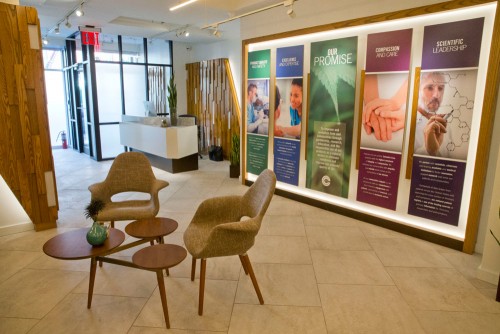WHITE PLAINS, N.Y. — When New York medical marijuana first became available this month, Brittany Barger was one of the first patients to navigate the state’s rules and make it through a dispensary door.
“When you’re as sick as I am, you’ll try anything,” said Barger, who has ovarian cancer that has spread through her 27-year-old body.
New York medical marijuana
Slow Start: In all of New York, just 71 medical marijuana patients
Coming to New York: Certified kosher medical marijuana products
Sooner Than Expected: New York giving critically ill fast track to medical marijuana
NEW: Get podcasts of The Cannabist Show.
Subscribe to our newsletter here.
Watch The Cannabist Show.
New York’s program — one of the strictest out of the 23 states that allow medical marijuana — has had a widely anticipated slow beginning, but there are signs it’s gaining momentum.
The state Health Department says more than 165 patients have now qualified, a figure that’s more than doubled in a week but is still just a sliver of the potential patient pool. More than 225 doctors have now taken the state-required training, up from about 150 last week.
Seven of the eight dispensaries that opened around the state Jan. 7 have seen patients, sometimes more than anticipated, or have appointments scheduled, operators say.
The Health Department is “extremely pleased” with the program’s launch, spokesman JP O’Hare said.
Still, some would-be patients say they’re stymied, unable to get access to any of the doctors prepared to see them. The state hasn’t released physicians’ names, although a few have announced themselves publicly. The Health Department said this week it would soon give a list to practitioners, though not to the public, citing security concerns.
While some other states’ medical marijuana programs also have faced questions about accessibility, New York is one of the few states to require physician training. New York also allows only cannabis extracts in pills and liquids, not pot in joints or brownies, a provision echoed only in Minnesota. And New York’s 10 qualifying illnesses also exclude some conditions other states allow, such as chronic pain in itself.

The requirements surprise some patients who call Etain Health’s dispensaries in Kingston, where the first few clients had appointments set for Saturday, and Albany, where patients are still awaited, the company said.
“We expected a very slow start,” said Chief Operating Officer Hillary Peckham, who feels there’s “a learning curve, but I don’t think it’s something that can’t be overcome.”
Meanwhile, patient traffic, in the dozens, is beating expectations at Columbia Care’s Manhattan dispensary, CEO Nicholas Vita said.
There have been a handful of patients at Vireo Health of New York’s dispensary in suburban White Plains and at PharmaCannis’ facilities near Buffalo and Syracuse, the companies said. Bloomfield Industries would say only that it has seen patients in its two dispensaries, also in the Syracuse and Buffalo areas. All the operators are slated to open more facilities, for a total of 20.
State officials say they responded to patients’ interest while providing for closely supervised, carefully calibrated products. But to patients like Donna Romano, they’re too hard to get.
During years of living with multiple sclerosis, Romano has found ways to get pot that she finds relieves her pain and muscle stiffness. She hopes pharmaceutical-grade products will help even more. But the Syracuse resident hasn’t found a nearby physician who’s prepared to certify her for the drugs.
“It’s frustrating, it’s aggravating, and some people are losing hope,” said Romano, 60.
While some doctors are supportive of medical marijuana, others are concerned about a drug that remains illegal under federal law and fear patients might abuse the system to get it, says Dr. Michael T. Goldstein, an ophthalmologist and president of the New York County Medical Society, a Manhattan physicians’ group.
Dr. Margaret Lewin, a Manhattan primary care physician, is taking a middle path. She plans to take the course to learn about the products, but not to prescribe them, as she thinks specialists will become experts on them. But she’ll consider referring people to such doctors “once I’m more knowledgeable,” she said.
Barger, the cancer patient, went to the dispensary hoping for an alternative to painkillers that had come with serious side effects. Fighting a cancer unsuitable for surgery and unresponsive so far to chemotherapy, she’d lost 100 pounds because she couldn’t keep food down. Simply seeing a movie became a major undertaking.
While noting it’s early to draw conclusions, she says that since she started using a cannabis vaporizer and capsules, she’s needed fewer pain pills, feels more relaxed and has her appetite back. The biggest plus, she says, has been joining her family for meals.
“With this, I’m hoping to have more good days,” she said, “and be able to check some more stuff off my bucket list.”
